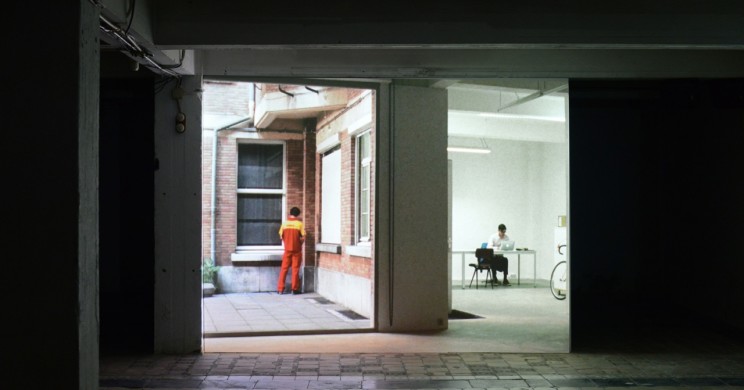With The Painter and the Deliveryman Rosalind Nashashibi offers a play on motifs, causality and narrative. Arriving at Objectif Exhibitions in Antwerp, the visitor is greeted by the emptiness of the ground floor gallery, a spacious white-walled and concrete-floored contemporary art space with large windows overlooking a small courtyard. The two 16mm films that give the exhibition its title are projected on loop in HD video in the basement, where they alternate next to one another in a clever and simple right angle set-up.
It must have been pure coincidence that I saw The Painter first, followed by The Deliveryman (both 2013). As causality remains an a priori faculty of our mind (for those who care, there is some Kant to be consulted here), and as video can be seen as the medium par excellence to play with causality (Fischli/Weiss’ iconic Der Lauf der Dinge being perhaps the best example of this), it seems only right to assume the arbitrary order in which the viewer finds the videos is deliberately left to play out with each visitor anew.
The Painter shows us a woman absorbed in the rather brutal process of applying paint on a large stretched canvas using an oversized mop, her brush strokes swooshing like relentless waves hitting the shore. Using a cleaning device, the painter ironically smudges and stains nearly every surface she encounters, including her own clothing. Both canvases end up as gray-white-beige non-paintings, the kind of which relatives we are ashamed of would say: “my 6-year old daughter makes better art that this.” And behold, a jump cut offers us the sight of a child’s drawing hanging on the painter’s studio wall: a horse carrying a little girl on its back and leaving behind a trail of manure.
The painter, Renée Levi, is a real-life artist, and Nashashibi’s invasion of her studio evokes those documentaries on the life and work of artists made in the mid-twentieth century, when it was still okay to think of the artist as a solitary genius. Or when it was miraculous to see Picasso draw a charcoal dove on a piece of white paper in The Mystery of Picasso (1956, Henri-Georges Clouzot). The idea that we could learn about art through close observation of the way it is made seems rather naïve amid today’s post-studio practices. Yet Nashashibi pointed her camera at this very classic trajectory where art takes place: on the axis between production and reception.
The Deliveryman shows a package being delivered at Objectif Exhibitions, upstairs, in the office. The package delivered could be one of the paintings, unstretched and folded for transport, although nothing indicates The Painter was shot prior to The Deliveryman. And besides, the enigmatic package is never opened, and as the title points out, the focus lies on the DHL deliveryman, not the delivered goods. Or is it? With the formalities of handing over the package out of the way, the deliveryman finds himself in need of relief, and delivers a generous quantity of liquid discharge in a corner of the courtyard. In a striking Jeff Wall-esque tableau we see on the one side the aforementioned art administrator—played by Objectif Exhibitions director Chris Fitzpatrick—sitting at his desk, while on the other side of the shot, divided by a wall and conveniently blinded windows, the deliveryman is having a long and clandestine wee. Nashashibi ends this little tranche de vie with a well-framed close up of the wetted bricks and pavement, silent and ephemeral witnesses of the conducted misdemeanor.
In the most simple yet poignant way, having climbed the stairs back up to the ground floor, the visitor is confronted with the almost exact same view as the tableau just described. Although the audience has passed through this space before, upon return they are faced with the set of one of the videos just seen. And indeed, that guy who signed the DHL form is sitting at that same desk. Is this a performance? Surely many visitors are tempted to investigate the courtyard for traces of the deliveryman’s urinal transgression.
Is Nashashibi taking the piss out of us? Isn’t it all on the verge of not meaning anything at all? Or is it all too much of a self-indulgent portrait of the art world, scatology from studio to exhibition hall? The open-endedness saves it. The making of the paintings, the delivery of both package and pee: it all passes through human hands. The same goes for the child’s drawing and the signature of the arts administrator on the DHL form. The indexicality of these acts points towards the other end of the camera, where a non-fictional artist and curator plotted these two videos featuring their own alter egos. Although both videos would work in other settings as well, as a duo they surmount their own inherent narrative and visual quality by their ingenious installation. This smart and playful contemplation on the tension between sites of production and presentation is present twice, simultaneously enforcing and short-circuiting itself: it is felt in the pairing of The Painter and The Deliveryman, as well as in the spatial experience so subtly imposed on each visitor.
By Samuel Saelemakers
























